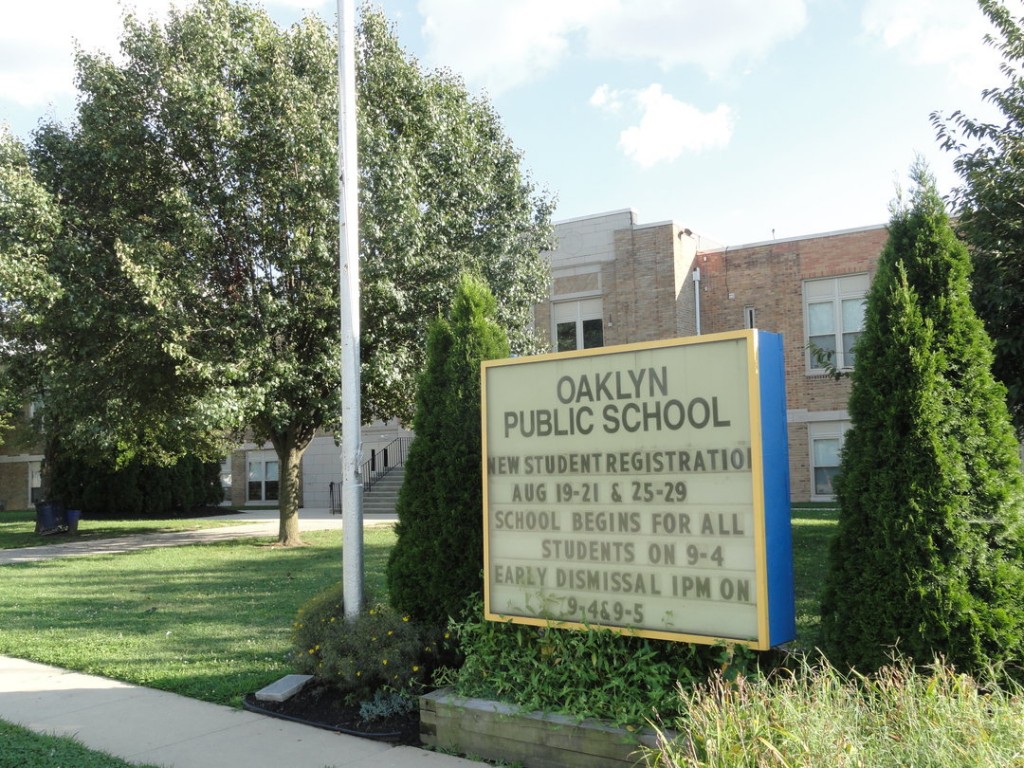Resolving the financial issues of the small district will require some creative problem-solving, says Superintendent Scott Oswald.
By Matt Skoufalos

The Oaklyn School is home to some 400 students, but its financial future in the next three years is uncertain at present. Credit: Matt Skoufalos.
When the Oaklyn school district opens the doors to its lone building on September 4, some 400 kids will fill its classrooms, from kindergarten through ninth grade.
Halls that produced back-to-back Camden County Teachers of the Year Patrice Steller and Sandra Carro will spring to life after a summer off.
In the past few years, however, the bell that marks the beginning of the day has been ushering in fewer students, sending its overseers scrambling to catch up with a budget shortfall that has effectively pushed the small district to the financial brink.
“The problems are real,” said Oaklyn Board of Education President William Stauts. “The cause is allowing Hi-Nella to leave.”
The Hi-Nella pullout
A longstanding receiving arrangement with the tiny borough of Hi-Nella, just six miles south, used to bring in as much as $800,000 to the Oaklyn district—about 10 percent of its annual budget, said Scott Oswald, joint superintendent of the Collingswood and Oaklyn school districts.
But four years ago, Hi-Nella started pulling its students out of Oaklyn to send them to the neighboring Stratford school district. When they left, so did their tuition dollars.
“It’s very nice for the Hi-Nella residents, but it doesn’t do anything for Oaklyn,” Stauts said, adding that the borough took on responsibility for the Hi-Nella students “when nobody would have them.”
In short, a district that carried a $250,000 surplus into the 2013-14 school year will essentially run out of money halfway through 2016-17.
“It’s a tiny little district,” Oswald said. “Their common costs that every school faces are not spread across a lot of kids.
“Our expenses, much of which are out of our control, just continue to rise at a rate that surpasses the primary ways we get revenues, which is local taxes and state aid,” he said.
‘The obvious options don’t save enough money’
Against that loss of revenue, local taxes and state aid to the district are only projected to increase marginally from 2015-18, creating widening deficits of approximately $112,000, $115,000, and $117,000, respectively, in those years.
The Oaklyn school district tried to plug that hole by applying to the New Jersey Interdistrict Public School Choice program to add room for 52 additional students; it was awarded 14.
“Had we been able to get those seats, none of this would have happened,” Oswald said.
Moreover, because the Hi-Nella pull-out affected students at all grade levels throughout the district, cutting costs by simply reducing staff at the Oaklyn school would not have resolved the issue.
“Many of the reductions in Oaklyn have been a result of attrition,” Oswald said. “We have done some creative things with scheduling and staffing. We’re at the point where we don’t have any staff members left that we don’t absolutely need.”
Complicating the problem is the fact that the Oaklyn and Collingswood school districts are already so tightly integrated that the most apparent cost-saving measures—the districts already share administrative, maintenance, and technology services—would not necessarily save enough money to be worthwhile.
“Some districts that ultimately merge, however that merger happens, when you lay it out on paper, you can see where it makes sense,” he said; “you can see where the money’s going to be saved.”
But in this case, none of the “obvious options…seem to save enough money to really dig them out,” he said.
Leaving a void
Sharing teachers would increase costs, because the Collingswood salary scale is higher than that of Oaklyn. Sending Oaklyn’s ninth- or sixth-grade students to Collingswood isn’t going to save the district money, or could cost more. “Very, very rough numbers” on renting the Oaklyn school to Collingswood in a tuition exchange arrangement would only save $40,000 annually, Oswald said, “which is nothing.
“None of the answers to those easier solutions have been very favorable,” he said. “Other options, whatever they may be, would seem to be a bit more complicated and probably a bit more messy.”
The biggest hurdle to clear is the size of the Oaklyn elementary school population, and “I don’t know another district that has space to absorb 300 kids,” Oswald said.
“There’s a problem when a school system is designed to serve certain populations, and then those situations change,” he said.
“Stratford is a great little district and the [Hi-Nella] kids are going to be around the corner from their homes, [but] the Oaklyn School was designed to house and handle and educate those kids,” Oswald said.
“When you pull them out, you can’t just leave that big void there,” he said. “You can’t just manipulate the whole system without ramifications.”
What’s more, Oswald believes that Oaklyn is “certainly not alone in traveling down this path.
“I do feel that Oaklyn is ahead of the curve,” he said; “I do fear that we’re blazing some trails. The Department of Education has absolutely told us that there are other [districts] that are not far behind.”
Nonetheless, Oswald is confident that a solution will be reached.
“If Collingswood is involved, I do not see a future right now that does not keep that building open,” he said. “To the outsider, I don’t think they’re really going to see a difference.”
Stauts agreed.
“The school is not going to close,” he said. “The function may change.”



